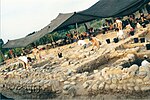Sha'ar HaGolan (archaeological site)
Sha'ar HaGolan is a Neolithic archaeological site near Kibbutz Sha'ar HaGolan in Israel. The type site of the Yarmukian culture, it is notable for the discovery of a significant number of artistic objects, as well as some of the earliest pottery in the Southern Levant.
The first Yarmukian settlement was unearthed at
The site was excavated by two teams from the Hebrew University of Jerusalem: one led by Moshe Stekelis (1949–1952), and the other by Yosef Garfinkel (1989–90, 1996–2004), and later co-directed with Michele A. Miller (1998-2000). While during the earlier excavations no architecture was found, the second expedition uncovered large courtyard houses, ranging between 250 and 700 m2 in area. The courtyard house makes its first appearance at Sha'ar HaGolan, giving the site a special significance in architectural history. This is an architectural concept still found among traditional Mediterranean societies. Monumental construction on this scale is unknown elsewhere during this period. The houses consist of a central courtyard surrounded by several small rooms.
The houses were separated by streets, which constitute evidence of advanced community planning. The dig uncovered a central street about 3 m wide, paved with pebbles set in mud, and a narrow winding alley 1 m wide. These are the earliest streets discovered in Israel and among the earliest streets built by man. A 4.15 m well dug to the local water table indicates a knowledge of hydraulics. Exotic objects discovered during the excavations include sea shells from the Mediterranean, polished stone vessels made of alabaster (or marble), and blades made from obsidian from Turkey. The presence of obsidian points to trade connections extending over 700 km.[2]
Pottery

The greatest technological innovation of the Sha'ar HaGolan Neolithic was the manufacture of
At the site of
In July 2022, archaeologists from the Israel Antiquities Authority announced the discovery of a 8000 years-old "Mother Goddess" figurine. Anna Eirikh-Rose, co-director of the excavation reported that the 20-centimeter long figurine covered by a bracelet with a red bottom was found broken into 2 pieces. It was sculpted in a sitting position with big hips, a unique pointed hat and what is known as ‘coffee-bean’ eyes and a big nose.[4][5]
-
Early Pottery Vessels, Yarmukian Culture
-
Sha'ar HaGolan, pottery
-
Sha'ar HaGolan, zoomorphic figurine
-
Sha'ar HaGolan, clay figurine
Art
About 300 art objects were found at Sha'ar HaGolan, making it the main center of prehistoric art in Israel and one of the most important in the world.[
Gallery
-
Sha'ar HaGolan, excavations 1998
-
Sha'ar HaGolan, flint arrowhead
-
Sha'ar HaGolan, flint axe
-
Sha'ar HaGolan, well
-
Sha'ar HaGolan, courtyard buildings
References
- ^ a b Garfinkel Y. 1993.
- ^ a b c Garfinkel, Y. 1999.
- ^ The Neolithic Period 10.200-5000 BC (Jordan) doa.gov.jo - Jordan Department of Antiquities
- ^ "8,000-year-old Yarmukian 'Mother Goddess' figurine uncovered in Israel". The Jerusalem Post | JPost.com. 7 July 2022. Retrieved 2022-07-31.
- ^ kayra, oguz (2022-07-08). "8,000-year-old Yarmukian 'Mother Goddess' figurine discovered in Israel". Arkeonews. Retrieved 2022-07-31.
Bibliography
- Garfinkel Y. 1993. The Yarmukian Culture in Israel. Paléorient, Vol 19, No. 1, pp. 115 – 134.
- Garfinkel Y. 1999. The Yarmukians, Neolithic Art from Sha'ar Hagolan. Jerusalem: Bible Lands Museum (Exhibition Catalogue).










